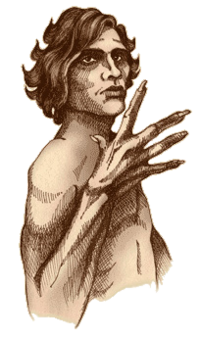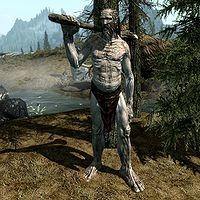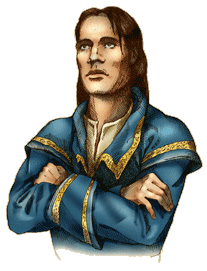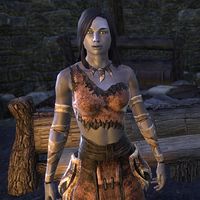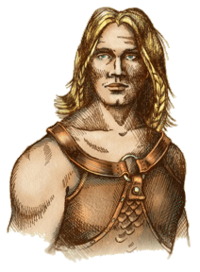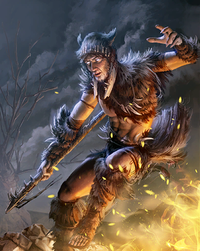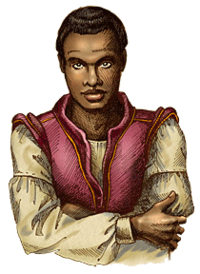Lore:Man
Man, meaning human, is used to refer to any of the human races of Mundus, such as the Nords, Imperials, Bretons and Redguards. While the Bretons are the result of interbreeding between Aldmeri and Nedes,[1] they are most commonly considered men, and not mer.[2] Some races of men have disappeared or otherwise died out, such as the Kothringi. Though it typically connotes the races of men, "human" is still used by various races in reference to the humanoid shape or ability, or to collectively refer to any member of a civilized race, but mainly when it comes to races who can mate with each other and produce offspring. Man, Elves and Beastfolk are classified under the definition of both men, and human by Imperial scholars.[3] Some consider the races of Men to be less distinct than those of Mer, with more arbitrary boundaries.[4]
Bretons[edit]
Bretons (from the Ehlnofex beratu meaning "half") are a hybrid race of both human and elven ancestry that primarily inhabit their ancestral homeland of High Rock, and the Systres Archipelago. High Rock is fractious and divided politically, which is seemingly encouraged by the layout of the land itself. Warfare between kingdoms accounts for much of Breton history. Despite this, Bretons across the province share many facets of culture, including language, bardic traditions, and heroic tales. Bretons make up the peasantry, soldiery, magical elite, and ruling families of the feudal kingdoms competing for power within High Rock, but the race can also be found around the rest of Tamriel, often as merchants or mercenaries. Bretons are distantly related to the Reachfolk.[nb 2]
Bretondom originated from the Nedes of High Rock and Aldmer interbreeding for centuries as far back as the Merethic Era. This mixed ancestry gives Bretons a unique perspective of the Nirn's oldest feud: the conflict between men and mer. The Bretons' Nedic ancestors are referred to as the Druids of Galen (or proto-Bretons) by retroactive nomenclature, while Clan Direnni are primarily credited as being their Aldmer ancestors. Druidic spellcraft (which differs from the arcane) is said to be the first truly Breton creation. Bretons have a natural affinity for environmental manipulation, which druids believe should be utilized to enhance or perfect nature, reshaping it just as their god Y'ffre once did.
The Direnni left a significant mark on the Bretons. The race's obsession with nobility, status, and lineage can be traced back to their days as vassals of Clan Direnni. Bretons possess an inborn and instinctive bond for the magical arts, often attributed to their elven blood. They are known for their intelligence and have a quick and perceptive grasp of spellcraft, enchantment, and alchemy. However, it is often difficult for an individual Breton to leave a lasting impression on the greater magical community; the very same mystical aptitude that produces such widespread natural talent also makes it much harder for Breton mages to stand out. Their human lifespans put them at a disadvantage relative to their elven peers, whose naturally long lives allow them more time to study, hone their skills, and make a name for themselves. Despite this, several Bretons have managed to cement themselves among the most well-regarded mages in history, with notable figures such as Voernet, Druid King Kasorayn, and Gyron Vardengroet. Despite the inherent Altmeri weakness to magical attacks, this trait did not carry over to the Bretons. Even the humblest of Bretons can boast a high resistance to destructive and dominating magical energies.
What it means to be a Breton is considered an age-old quandary by their people. To make sense of it all, some may focus on a specific aspect of their culture, or seek to blend it all together. Some Bretons hold their elven heritage in high esteem, which may influence them to worship Phynaster, the patron deity and "teacher" of the Direnni. Others attempt to seek out the druidic roots of their Nedic ancestors and reconnect with nature. Knighthood is pivotal to the Breton identity; its earliest practitioners served under Clan Direnni, but knights are credited with kickstarting High Rock's modern cultural history through tales of liberating the race from their Elven oppressors. These knights of old set the example for those that followed by going on grand quests for adventure and glory. In their free time, Breton youths of all walks of life imitate knights through chivalric pursuits in their thoughts or by their actions. Indeed, the profession encapsulates the traditional chivalric principles of Breton society, and the "quest-obsession" that has become a national identity for High Rock.
For more information, see the main lore article.
Giant[edit]
Giants (sometimes called the big folk) are a race of enormous humanoids with colossal strength. They are found in the wilderness of Skyrim, High Rock, Hammerfell, Cyrodiil and Valenwood.
They have thick grey skin, long, powerful limbs, large hands and feet, and thick greyish-brown hair decorated with braids and beads. Additionally, most Giants have decorative scars carved into their chests. They clothe themselves in fur pelts adorned with the bones of animals and people, although many prefer a simple loincloth.
Although they tower above most races, their height can vary. Some stand between 11 and 12 feet tall, whereas others can be several times the height of the average person. Female giants, also called Giantesses, are less commonly seen than males by non-giants, and the only known sightings of them have been in the Wrothgarian Mountains and Whiterun Plains during the Second Era. Giant social groups appear to vary, with some being part of clans led by a chieftain, some being led by powerful matriarchs, and others being small families composed of two parents raising children together on isolated mountains.
Horwalli[edit]
The Horwalli are a tribal race of Men that lived in Black Marsh. Scholars theorize they were either sent there as refugees or prisoners, or that they settled along the coastal waterways and adapted to the environment. They resided in the region well throughout the First and Second Eras, but were considered to no longer inhabit the province by the late Third Era.
For more information, see the main lore article.
Imperials[edit]
The Imperials, also known as Cyrodiils, Cyrodilics, and Imperial Cyrods, are the well-educated and well-spoken natives of the civilized and cosmopolitan province of Cyrodiil. Imperials are also known for the discipline and training of their citizen armies, and their respect for the rule of law. Imperials have proved to be shrewd diplomats and traders, and these traits, along with their remarkable skill and training as infantry, have enabled them to colonize various other nations and create the Empire. Their hegemony has waxed and waned throughout the eras, and most historians refer to three distinct Empires, the ends of which each mark a new epoch in Tamrielic history.
For more information, see the main lore article.
Cyrodiil is a pretty blanket term for almost every element of the Imperial Province: the people are called the Cyrodiils, the land is called Cyrodiil, the capital city of their province is called Cyrodiil, and the ruler of the land no matter their race is called The Cyrodiil. this is derived from a king-is-the-land tradition that reaches back to when the Elves ruled the land.
Kothringi[edit]
The Kothringi (or Lustrous Folk) are a silver-skinned tribal people indigenous to Black Marsh who are believed to be descendants of the Nedes. Once considered the only humans native to Tamriel, they are now known to have shared the continent with many other tribal groups. The race was believed to have been driven to extinction by the Knahaten Flu in the Second Era.
For more information, see the main lore article.
Nedes[edit]
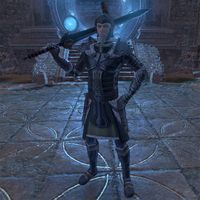
- "...human settlers occupied nearly every corner of Tamriel before Skyrim was even founded. These so-called "Nedic peoples" include the proto-Cyrodilians, the ancestors of the Bretons, the aboriginals of Hammerfell, and perhaps a now-vanished Human population of Morrowind. " —Frontier, Conquest
The Nedes (also known as the Nedic peoples or rarely Nedelings) were a human race (or a group of races) of unknown extraction, who inhabited much of Tamriel during the Merethic and First Eras. The Duraki society of the Nedes who lived in Hammerfell (then called the "Deathlands") largely followed the Cult of the Stars which revolved around the worship and study of the constellations, and beings known as the Celestials. Nedic culture experienced a sharp decline over several centuries as they began to assimilate into other cultures, before being completely exterminated by the Yokudan invasion of Hammerfell.
For more information, see the main lore article.
Nords[edit]
Nords (also known as Northmen, or called Bron singular in the Language of Dragons) are the Children of the Sky, a race of tall and fair-haired humans from Skyrim who are known for their incredible resistance to cold and magical frost. They are fierce, strong and enthusiastic warriors, and many become renowned warriors, soldiers and mercenaries all over Tamriel. Eager to augment their martial skills beyond the traditional methods of Skyrim, they excel in all manner of warfare, and are known as a militant people by their neighbors. Nords were known for a time for their nautical prowess when they migrated from Atmora. Seafaring merchants or smugglers are not unheard of, as was the case with Tobias.
When the descendants of the Atmorans transitioned into calling themselves Nords is blurred. The inhabitants of Skyrim during the Dragon War were variously labeled Nords and Atmorans. The truth may lie somewhere in-between; while the two are considered distinct races, the men living in the transition period between the terms' respective usage have been considered 'proto-Nords'. High King Harald started a trend when he relinquished all holdings in distant and lost Atmora and united the disparate Nordic people to formally create the Kingdom of Skyrim. What followed was the "first Nords" under Harald wished to distinguish themselves from their Atmoran ancestors, but they still felt pride for their ancient heritage. However, according to Great Harbingers, these people didn't consider themselves Nords until sometime after the Redguards arrived to Tamriel.
For more information, see the main lore article.
Orma[edit]
The Orma are a tribe of Men native to Black Marsh, along with the indigenous Horwalli, Kothringi, and Yespest. How they arrived in Black Marsh is unknown, with scholars theorizing they were possibly sent there as refugees or prisoners, or settled along the coastal waterways on their own and adapted to the environment. The Orma lived in Argonia well throughout the First and Second Eras, but were considered to no longer inhabit the province by the late Third Era.
Orma are born without eyes, becoming masters of their other senses, including that of touch. Their skulls are peculiar for lacking eye sockets. One such skull was noted by bone canister scrolls to be used as a door marker for a room containing powerful artifacts in Scourg Barrow.
One of the few known members of the race was Catchica, who was with Reman's army at Caer Suvio when Juilek Cyrodiil was poisoned before the battle at Bodrum. She later worked at Mir Corrup, a resort in Nibenay, to falsely implicate the Emperor's mistress in a plot to poison the Emperor.
For more information, see the main lore article.
Reachmen[edit]
The Reachmen, also known as the Reachfolk, Witchmen of High Rock, and Witchfolk of the Reach, are a race of humans who are native to the Reach in southwestern Skyrim and the neighboring Western Reach in the east of High Rock, where some Reachfolk families originated from. They are believed to be closely related to the Bretons. While Reachmen are distinct, they are also mixed with other races that make up Man, Mer, and even Daedra. Similarly to the Bretons, Aldmeri blood runs through their veins, which stems from the Direnni Hegemony's occupation of the Western Reach in the early First Era.
At least some Reachmen are known to be descended from the Keptu clan of Nedes. Although they are thought to share descent, Bretons do not consider themselves kin to the Reachmen, and the Reachmen do not see themselves as Bretons. This sentiment is shared by other races.
Unlike their Breton cousins, who are typically pale and of slight build, Reachfolk are more diverse in appearance, ranging from short and slight framed to taller, broader, and muscular builds, more typical for Nords. Some of the Reachfolk have traits closer to those typical to the inhabitants of the Cyrodiil and a few bear a distinctive red eye color.
Redguards[edit]
Redguards are a human race that primarily inhabits the province of Hammerfell, but have roots that can be traced back to the continent of Yokuda. Known for their unique martial culture, they are reputed as brilliant battlefield tacticians who are quick to adopt new styles of armor and weaponry. They are the most naturally talented warriors in Tamriel. Hammerfell was formerly known as the Deathlands, as it hosts an arid climate with stifling, sandy winds, baking rocks that would brand one's feet, and terrible creatures that dwell in the crags and dunes. Regardless, conquering this hostile environment has become synonymous with Redguard culture. Aside from being physically blessed with hardy constitutions, they also have a resistance to poison and fleetness of foot. Redguards are known for their love of traveling, adventuring, and sailing the high seas: they can be seen commonly throughout Tamriel as sailors and mercenaries.
For more information, see the main lore article.
Yespest[edit]
The Yespest (or Yerpest) are a tribe of Men indigenous to Black Marsh, along with the Horwalli, Kothringi, and Orma. How they arrived in Black Marsh is unknown, but it is possible that they were sent there as refugees or prisoners. Alternatively, they may have settled along the coastal waterways on their own and adapted to the environment. The Yespest were active in the region around Blackrose. They may have been contemporaries of the Barsaebics, and some Imperial scholars erroneously credit them with building the ancient Argonian xanmeers.
For more information, see the main lore article.
Notes[edit]
- There's some suggestion that early Bosmer were known for intermarrying with humans.[5]
- Due to their alleged shared ancestry,[UOL 1] the races of Men are often compared to apes derogatorily.[6][7][8][9]
- For a list of notable humans, see here.
References[edit]
- ^ Pocket Guide to the Empire, 1st Edition: High Rock — Imperial Geographical Society, 2E 864
- ^ Pocket Guide to the Empire, 3rd Edition: All the Eras of Man, A Comprehensive History of our History — Imperial Geographical Society, 3E 432
- ^ Dialogue in Morrowind
- ^ Loremaster's Archive - Tamriel's Dungeons — Dhulef
- ^ The Monomyth
- ^ Dunmer of Skyrim — Athal Sarys
- ^ Neramo's dialogue in ESO
- ^ Suryn Athones' dialogue in Morrowind
- ^ M'raaj-Dar's dialogue in Oblivion
Note: The following references are considered to be unofficial sources. They are included to round off this article and may not be authoritative or conclusive.
- ^ The Dreadful Theft of the Sun's Dusk Ale — Rascien Wickersly
|
|||||||||||||||||||||||||||||||||||||||||||
